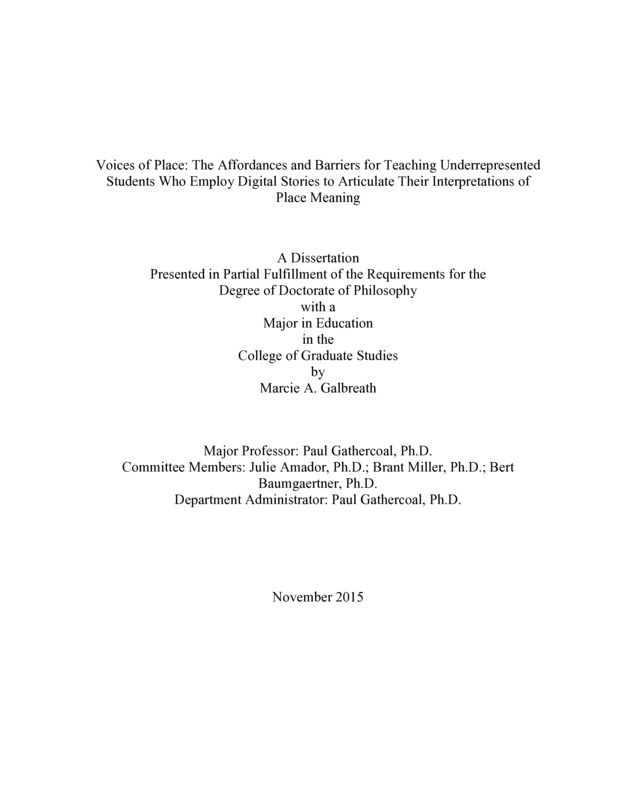Voices of Place: The Affordances and Barriers for Teaching Underrepresented Students Who Employ Digital Stories to Articulate Their Interpretations of Place Meaning
Galbreath, Marcie Anne. (2015). Voices of Place: The Affordances and Barriers for Teaching Underrepresented Students Who Employ Digital Stories to Articulate Their Interpretations of Place Meaning. Theses and Dissertations Collection, University of Idaho Library Digital Collections. https://www.lib.uidaho.edu/digital/etd/items/galbreath_idaho_0089e_10767.html
- Title:
- Voices of Place: The Affordances and Barriers for Teaching Underrepresented Students Who Employ Digital Stories to Articulate Their Interpretations of Place Meaning
- Author:
- Galbreath, Marcie Anne
- Date:
- 2015
- Keywords:
- Digital Stories Science
- Program:
- Curriculum & Instruction
- Subject Category:
- Education; Curriculum development; Educational technology
- Abstract:
-
Marginalized and underrepresented students struggle to find meaning in mainstream curriculum and instruction. This study was designed to explore the affordances and barriers for teaching underrepresented students who make digital stories to articulate place meaning as part of an environmental science curriculum. Additional questions were developed to examine: 1) what key experiences contribute to deeper place meaning? 2) what affect digital storytelling has on border crossing? and 3) how the introduction of technologies positively or negatively impact novelty space?
A mixed methods case study design was employed. The study used a non-equivalent control group design. The control and treatment groups were assigned by random draw and consisted of fifth grade students in two intact classrooms from one rural school. The instrument used for pre- and post-test surveys as well as coding storyboards and digital stories was based on the Semken and Freeman (2008) model of Young’s (1999) Place Meaning Survey (PMS). All participants produced storyboards. The treatment consisted of digital stories created on iPads by the treatment group.
Quantitative results from this study were confounded by the PMS. The PMS was described as being too subjective and this raised questions regarding its’ validity and reliability with the subject population. Novelty space, the Hawthorne effect, and diffusion had a negative impact on a connection to and articulation of place meaning; all limitations resulted from technology use, not digital storytelling. The findings did show a relationship between digital storytelling and border crossing at the dependent collateral learning level. When examining key experiences to deeper place meaning, all qualitative data points to the environmental activities and storyboards as affordances. The digital stories displayed nuances of place meaning; however, deeper place meaning was only explicit in participants’ storyboards. Compared to the control group, the treatment group displayed significant growth in perceived science competency after completing the treatment, χ2 (4, N = 50) = 5.89, p = 0.02.
- Description:
- doctoral, Ph.D., Curriculum & Instruction -- University of Idaho - College of Graduate Studies, 2015
- Major Professor:
- Gathercoal, Paul
- Committee:
- Amador, Julie; Miller, Brant; Baumgaertner, Bert
- Defense Date:
- 2015
- Identifier:
- Galbreath_idaho_0089E_10767
- Type:
- Text
- Format Original:
- Format:
- application/pdf
- Rights:
- In Copyright - Educational Use Permitted. For more information, please contact University of Idaho Library Special Collections and Archives Department at libspec@uidaho.edu.
- Standardized Rights:
- http://rightsstatements.org/vocab/InC-EDU/1.0/

